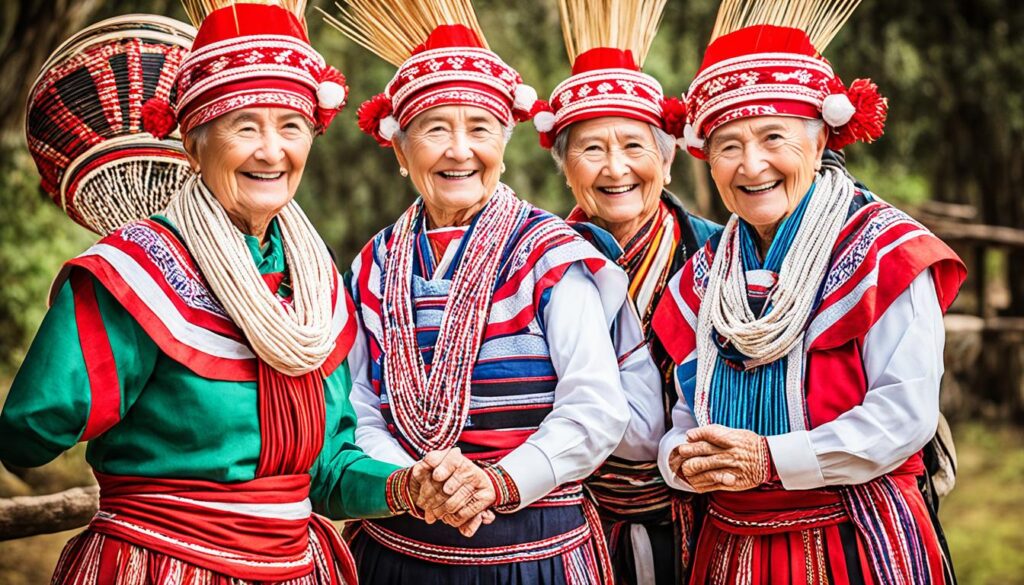Did you know that the S’gaw Karen language, also known as Karen, is spoken by over 2 million people in Myanmar and Thailand?
This unique indigenous language holds immense cultural and linguistic significance for the Karen ethnic group, who primarily inhabit the Ayeyarwady delta region in Myanmar as well as parts of Thailand. With its rich history, distinctive alphabet, and various dialects, the S’gaw Karen language reflects the diversity and heritage of the Karen people.
In this article, we will delve into the fascinating aspects of the S’gaw Karen language, including its history, distribution, phonology, and cultural etiquette. Join us on this exploration of one of Thailand’s remarkable indigenous languages.
History of the S’gaw Karen Language
The S’gaw Karen language, also known as Karen, is a fascinating part of the Karenic branch of the Sino-Tibetan language family. It has a rich history and is considered an important cultural and linguistic heritage of the Karen people. The language has been used as the official language in the Kayin State of Myanmar and by the Karen National Union (KNU) organization, which has been fighting for the rights and autonomy of the Karen people since the 1940s.
One significant milestone in the history of the S’gaw Karen language is the publication of the Bible translation in 1853. This showcases the significance of the language to the Karen people and their commitment to preserving their cultural identity and religious beliefs.
“The S’gaw Karen language is not merely a means of communication for our community; it is an integral part of our identity and cultural heritage.”
To fully understand the importance of the S’gaw Karen language, it is vital to delve deeper into its origins, evolution, and cultural significance within the context of the Karen people’s history and aspirations.
| Year | Significant Event |
|---|---|
| 1940s | The Karen National Union (KNU) organization fights for the rights and autonomy of the Karen people. |
| 1853 | The Bible translation in the S’gaw Karen language is published, showcasing the importance of the language to the Karen community. |
Distribution and Varieties of S’gaw Karen
The S’gaw Karen language, a significant part of Karen culture and identity, is primarily spoken in the Ayeyarwady delta area, which includes the Ayeyarwady, Bago, Kayin, and Rangon Regions in Myanmar. The language is also prevalent among the Karen people in the neighboring country of Thailand.
Within the S’gaw Karen language, there are several distinct dialects that exhibit regional variations. These dialects reflect the unique linguistic diversity of the S’gaw Karen community. Some of the main dialects include:
- Eastern Dialect (Pa’an): Spoken in the eastern part of the Karen State in Myanmar, this dialect showcases slight variations in vocabulary and pronunciation.
- Southern Dialect of Western Kayah (Dawei): This dialect is spoken in the southern region of Kayah State, showcasing its own linguistic peculiarities.
- Delta Dialect of S’gaw Karen: This dialect is predominantly spoken in the Ayeyarwady delta area and exhibits distinctive features compared to other dialects.
- Paku Dialect: Spoken in northern Kayin State and southern Kayah State, this dialect has its own unique characteristics.
- Mopwa Dialect: This dialect is spoken by the S’gaw Karen community in Kayah State and demonstrates specific linguistic traits.
- Mobwa Dialect: Spoken primarily in Thandaung township, Kayin State, this dialect has its own variations in vocabulary and pronunciation.
The various dialects within the S’gaw Karen language demonstrate the linguistic richness and cultural diversity of the Karen ethnic group.

Phonology and Alphabet of S’gaw Karen
The S’gaw Karen language boasts a unique and intricate phonology system, encompassing a diverse range of consonants and vowels. The Karen alphabet comprises 25 consonants, 9 vowels, 5 tones, and 5 medials. These components form the building blocks of the S’gaw Karen script, which draws its origins primarily from the Burmese script. Although there are slight variations in pronunciation, the letters of the S’gaw Karen alphabet closely resemble those of the Burmese script.
The S’gaw Karen language also incorporates different tonal patterns that significantly impact the meanings of words. The five distinctive tones add depth and nuance to communication, allowing speakers to convey emotions, intentions, and nuances effectively. Understanding the intricacies of tonal variations is essential for mastering the S’gaw Karen language.
The Karen script is written from left to right and does not require the use of spaces between words. This cohesive flow contributes to the seamless reading experience and aids in maintaining the integrity of the script’s structure. By following this pattern, S’gaw Karen script users can effectively communicate their thoughts and ideas without interruption or confusion.
Take a closer look at the S’gaw Karen alphabet in the image above, which presents the visually captivating and distinctive characters that form the foundation of this beautiful language.
Karen Culture and Etiquette
The Karen people have a rich culture and unique customs. They take great pride in their traditions and maintain strong connections to their ancestral roots. One notable aspect of Karen culture is their naming system. Unlike many other cultures, the Karen people do not have surnames. Instead, they use terms of kinship to address and identify themselves within their community.
Karen etiquette is deeply ingrained in their daily lives and interactions. Traditional Karen customs dictate that shaking hands or bowing is not customary when greeting others. However, due to increased exposure to Western culture, some Karen individuals may shake hands as a form of greeting.
When greeting someone, the Karen people typically use their right hand to greet while supporting their right forearm with their left hand as a gesture of respect. This traditional greeting is accompanied by a warm smile and a gentle nod of the head. It is important to note that the Karen people appreciate polite and indirect communication, as directness can be considered rude or aggressive in their culture.
“The Karen people have a strong sense of community and value harmony and consensus. They prefer to settle disputes and address conflicts peacefully through dialogue and mediation.”
Displays of anger or confrontational behavior are not respected in Karen culture and should be avoided. Instead, maintaining a calm and composed demeanor is highly valued.
The Karen people have specific norms regarding public displays of affection. Affectionate behavior, such as hugging or holding hands, is commonly observed between women and between men. However, public displays of affection between men and women are less common and often considered inappropriate in traditional Karen society.
Understanding and respecting the cultural etiquette of the Karen people is essential when interacting with them. By embracing their customs and traditions, individuals can promote cultural appreciation and foster positive relationships with the Karen community.

| Traditional Karen Etiquette | Modern Influences |
|---|---|
| Not shaking hands or bowing | Influenced by Western culture, some Karen may shake hands |
| Greeting with the right hand and supporting the right forearm with the left hand | Embracing elements of Western greetings |
| Polite and indirect communication | Adapting to more direct forms of communication |
| Avoiding displays of anger | Expressing emotions more openly |
| Affectionate behavior observed between women and between men | Limited public displays of affection between men and women |
Conclusion
The S’gaw Karen language, a unique Myanmar indigenous dialect spoken by the Karen people in Thailand, holds immense significance in Karen culture and identity. The distinct phonology and alphabet of this language serve as a reflection of the rich history and heritage of the Karen ethnic group. To truly embrace the diversity and linguistic richness of Thailand, it is crucial to gain a comprehensive understanding of the distribution, varieties, and cultural etiquette associated with the S’gaw Karen language.
The S’gaw Karen language has made its mark as an integral part of Karen culture, enabling communication and preserving traditions within the community. By exploring the distribution of this language, one can appreciate its widespread usage in various regions of Myanmar and Thailand. The different dialects, such as the Eastern dialect, Southern dialect, and Delta dialect, offer further insight into the linguistic diversity within the S’gaw Karen language.
Furthermore, cultural etiquette plays a vital role in the S’gaw Karen community. Understanding the way the Karen people communicate, greet one another, and express respect is essential for fostering cultural appreciation and meaningful interactions. By embracing the S’gaw Karen language, individuals embark on a journey of understanding and celebration of the diversity that Thailand has to offer.
FAQ
What is the S’gaw Karen language?
The S’gaw Karen language, also known as Karen, is a unique indigenous dialect spoken by the Karen people in Thailand. It belongs to the Karenic branch of the Sino-Tibetan language family and is spoken by over 2 million people in Myanmar and Thailand.
How is the S’gaw Karen language written?
The S’gaw Karen language is written using the S’gaw Karen alphabet, which is derived from the Burmese script. The Karen script consists of 25 consonants, 9 vowels, 5 tones, and 5 medials.
Where is the S’gaw Karen language primarily spoken?
The S’gaw Karen language is primarily spoken in the Ayeyarwady delta area, including the Ayeyarwady, Bago, Kayin, and Rangon Regions in Myanmar. The speakers of S’gaw Karen are often interspersed with Pwo Karen speakers.
Are there different dialects within the S’gaw Karen language?
Yes, there are various dialects within the S’gaw Karen language, including Paku, Mopwa, Wewew, and Monnepwa. Each dialect has its own unique characteristics and features.
What is the history of the S’gaw Karen language?
The S’gaw Karen language has a long history and has been used as the official language in the Kayin State of Myanmar and by the Karen National Union (KNU) organization, which has fought against the Burmese government since the 1940s. A Bible translation in the S’gaw Karen language was published in 1853, highlighting the importance of the language to the Karen people.
What is the cultural etiquette of the Karen people?
The Karen people have unique customs and etiquette. They do not have surnames but use terms of kinship to address each other. Traditional Karen etiquette includes greeting with the right hand and supporting the right forearm with the left hand as a sign of respect. Karen people appreciate polite and indirect communication, avoiding directness, which can be considered rude. Displays of anger should be avoided, and public displays of affection are uncommon.
